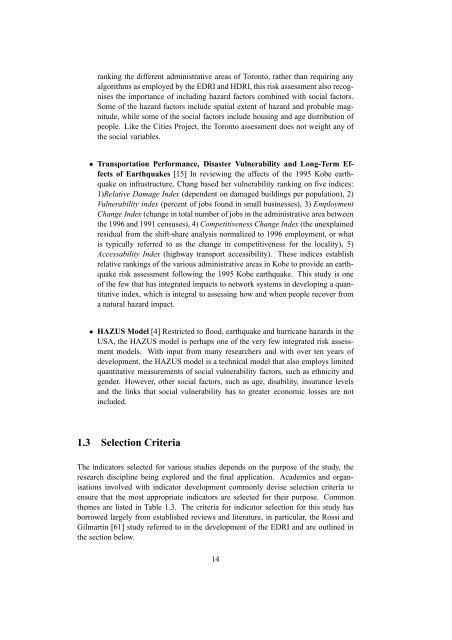Quantifying Social Vulnerability: A methodology for ... - EarthByte
Quantifying Social Vulnerability: A methodology for ... - EarthByte
Quantifying Social Vulnerability: A methodology for ... - EarthByte
Create successful ePaper yourself
Turn your PDF publications into a flip-book with our unique Google optimized e-Paper software.
anking the different administrative areas of Toronto, rather than requiring anyalgorithms as employed by the EDRI and HDRI, this risk assessment also recognisesthe importance of including hazard factors combined with social factors.Some of the hazard factors include spatial extent of hazard and probable magnitude,while some of the social factors include housing and age distribution ofpeople. Like the Cities Project, the Toronto assessment does not weight any ofthe social variables.• Transportation Per<strong>for</strong>mance, Disaster <strong>Vulnerability</strong> and Long-Term Effectsof Earthquakes [15] In reviewing the affects of the 1995 Kobe earthquakeon infrastructure, Chang based her vulnerability ranking on five indices:1)Relative Damage Index (dependent on damaged buildings per population), 2)<strong>Vulnerability</strong> index (percent of jobs found in small businesses), 3) EmploymentChange Index (change in total number of jobs in the administrative area betweenthe 1996 and 1991 censuses), 4) Competitiveness Change Index (the unexplainedresidual from the shift-share analysis normalized to 1996 employment, or whatis typically referred to as the change in competitiveness <strong>for</strong> the locality), 5)Accessability Index (highway transport accessibility). These indices establishrelative rankings of the various administrative areas in Kobe to provide an earthquakerisk assessment following the 1995 Kobe earthquake. This study is oneof the few that has integrated impacts to network systems in developing a quantitativeindex, which is integral to assessing how and when people recover froma natural hazard impact.• HAZUS Model [4] Restricted to flood, earthquake and hurricane hazards in theUSA, the HAZUS model is perhaps one of the very few integrated risk assessmentmodels. With input from many researchers and with over ten years ofdevelopment, the HAZUS model is a technical model that also employs limitedquantitative measurements of social vulnerability factors, such as ethnicity andgender. However, other social factors, such as age, disability, insurance levelsand the links that social vulnerability has to greater economic losses are notincluded.1.3 Selection CriteriaThe indicators selected <strong>for</strong> various studies depends on the purpose of the study, theresearch discipline being explored and the final application. Academics and organisationsinvolved with indicator development commonly devise selection criteria toensure that the most appropriate indicators are selected <strong>for</strong> their purpose. Commonthemes are listed in Table 1.3. The criteria <strong>for</strong> indicator selection <strong>for</strong> this study hasborrowed largely from established reviews and literature, in particular, the Rossi andGilmartin [61] study referred to in the development of the EDRI and are outlined inthe section below.14
















